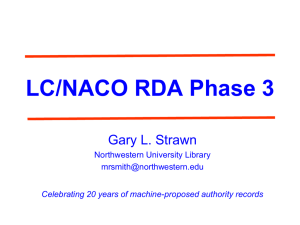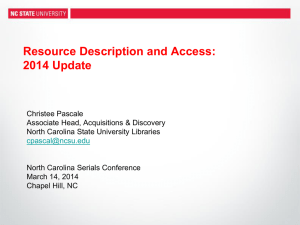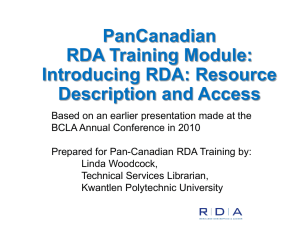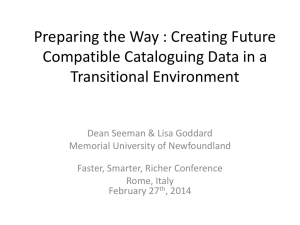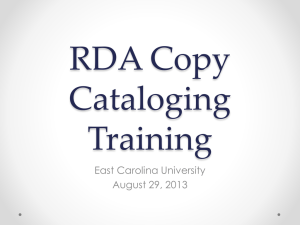RDA Authority Records in Voyager
advertisement
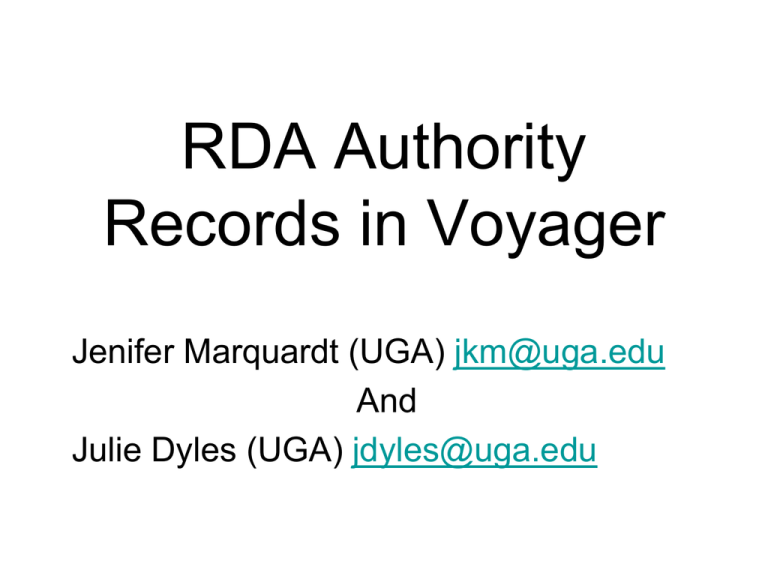
RDA Authority Records in Voyager Jenifer Marquardt (UGA) jkm@uga.edu And Julie Dyles (UGA) jdyles@uga.edu What we will cover • • • • Fields, codes and example records Entire words versus abbreviations Family as author, creator, etc. Fictitious persons/animals & real animals as authors, creators, etc. • Split file issues –Bible and Koran headings –Personal names –Names with uniform titles Your generic or locally created tag tables have been updated to accept RDA authority records – Example: 370 Associated Place • • • • • • • • • • • • • • • • • • • • • • • • • [370] 0=a 0A 1=b 0A 2=c 1A 3=e 1A 4=f 1A 5=g 1A 6=s 0A 7=t 0A 8=u 1A 9=v 1A 10=0 1A 11=2 0A Subfa=Place of birth Subfb=Place of death Subfc=Associated country Subfe=Place of residency/headquarters Subff=Other associated place Subfg=Place of origin of work Subfs=Start period Subft=End period Subfu=Uniform resource identifier Subfv=Source of information Subf0=Authority record control number Subf2=Source of term What are some of the new authority fields and codes? • Technical Bulletin 258 OCLC-MARC Format Update 2010 including RDA Changes (May 2010) http://www.oclc.org/support/document ation/worldcat/tb/258/ • 008/10 Descriptive Cataloging Rules “z” for other • 040 Cataloging Source |e Description conventions Other very normal looking records Very ordinary series authority record • 046 Special Coded Dates – Variety of meanings delineated by subfields |f is Birth date and |g is Death date (Note that information comes from the 670.) |k is Beginning or single date created (Again, this shows up in the 670) • 370 Associated Place |a Place of birth |b Place of death |c Associated country |e Residency/headquarters |f Other associated places |g Place of origin of work • 371 Address This is used for both postal and electronic addresses • 372 Field of activity • 373 Affiliation • 374 Occupation • 375 Gender • 376 Family information |a Type of family (clan, dynasty, royal) |b Name of prominent member |c Hereditary title • 377 Associated language – language that a person or organization uses for publication, communication, etc. • 380 Form of work - the class or genre of the work • 381 Other distinguishing characteristics of work or expression • 382 Medium of performance • 383 Numeric designation of musical work • 384 Key 4xx and 5xx fields • |w New code “r” for Relationship (what is relationship between the 4xx/5xx and the 1xx) • |i Relationship information • Display opportunities Name heading with a corporate body link Corporate body with corporate link and a personal name link Display possibilities So, the look of RDA authority records varies a good bit depending on if or how many new fields are used. Mixed code authority records • no |e rda in 040 • fields 046 and 370 added • RDA choice of heading given in 700 field Some headings are going to look different too. 1) Presentation and 2) Expansion of what you should include even if there is no conflict • • • • Frommer, Paul ǂc (Composer) Márton, István ǂc (Geologist) [Minguo] Hunan wen xian wei yuan hui Williams, Sidney ǂq (Sidney J.), ǂd 1947- No conflict with: Williams, Sidney, |d 1947- Changes in headings for persons from AACR2 to RDA GIL Users Group Meeting 2011 Changes to name headings for individuals In RDA, various changes have been made to the way that dates are recorded for persons (described now in AACR2 22.17): The examples at AACR2 22.17A include abbreviations for months in English. So name headings that contain a month in AACR2 look like this: The examples in RDA 9.3.2.3 do not include abbreviations for months in English. Also, RDA Appendix B does not contain any abbreviations for months. As a result, RDA name headings containing months will look like this: AACR2 rule 22.17A includes use of the abbreviations “cent.”, “ca.”, “b.”, “d.” and “fl.”. We are used to seeing AACR2 headings like this one, which contains the abbreviation “cent.”: RDA does not include these abbreviations. As a result, RDA name headings containing approximate dates in centuries will look like this: Instead of “ca.”, as we are used to seeing now… …RDA 9.3.1.3 prescribes the use of “approximately.” An example of an RDA record containing “approximately.” The abbreviation “fl.” will no longer be used when a period of activity is known but the exact years of a person’s birth and death are unknown. Instead, LC has chosen to substitute the term “active” for records like this created during the RDA test period. It appears that “flourished” is another option in accordance with RDA rules. As of this time, there are no sample records in OCLC using “flourished” in the name heading. Note that while AACR2 placed a time period restriction on using “fl.” dates (22.17A), there is no such restriction on recording time periods of activity in RDA. AACR2 prescribes the use of abbreviations “b.” and “d.” in headings for persons. Currently, “b.” is used when the year of death is unknown but the person is no longer living (LCRI 22.17), and “d.” is used when the year of birth is unknown but the year of death is known. RDA eliminates the use of “b.” and “d.” to denote birth/death dates. Instead, LC catalogers have chosen to use hyphens after a date of birth and before a date of death during the RDA test period. Other institutions have chosen to spell out “born” and “died” when creating RDA name authority records. RDA 9.19.1.3 gives examples which indicate that both of these methods are in accordance with RDA rules. Other abbreviations that will be eliminated are those in additions to titles of musical works. For example, the current abbreviation “arr.” … …will now be “arranged.” As in this example of a record created during the RDA test period. RDA will also require that the abbreviation “acc.” change to “accompaniment” and “unacc.” to “unaccompanied.” Changes to name headings for family names Under RDA rules, families can now be considered contributors to and creators of works. Distinct families can be given main entry on bibliographic records. This means that separate records will exist for family names in LC/NAF and LCSH. Subject headings will continue to be used for families as general groupings. These will be found in LCSH. Name headings will be used for distinctive family entities. These will exist in the LC/NAF. The definition of “family” in RDA is: Note that this record is particularly for those Hammons that are from or have some connection with West Virginia, and that the 667 specifies it is invalid for use as a subject. Note also that the 670s of the name heading list works which the Hammons family has performed or created… …as opposed to the subject heading record, where the Hammons (Hamann) family is the subject of a book. Another example of a name authority record for a distinctive family This heading contains the name of a prominent member of that family (rather than a place) in the delimiter g field. The name in the heading for the family should be in the established form of the heading for that name, but the delimiter d before the dates is not included. Changes to name headings for fictitious persons and animals and real animals RDA 8.1.2 defines a person as “an individual or an identity established by an individual (either alone or in collaboration with one or more other individuals).” While AACR2 21.6D1 also allows for main entry under shared pseudonyms, the scope statement at RDA 9.0 goes further in stating that personhood can include all fictitious entities. This differs from AACR2 (21.4C1) which does not allow for fictitious entities to be treated as authors. What this means is that instead of seeing a record with headings that look like this: We might see something like this. Under RDA rules, fictitious entities can be established as name headings and represented as creators if they are presented as such on the resource being cataloged. The headings for these persons are not qualified by (Fictitious character). Similarly, the Library of Congress Policy Statement relating to RDA 9.0 extends the scope of this rule to real non-human entities which have roles as creators or contributors. So while you currently see: If RDA is implemented, you might instead see Cheeta represented as the author of this work. When will we see headings like this in our catalogs? Current LC policy states that until there is a decision about implementation of RDA by LC, no changes of this kind will be made in the LCSH database. A list of subject headings like these is being compiled by the Policy and Standards Division for possible deletion if RDA is implemented. In review… What changes will you notice as more and more RDA records begin to come in to our catalogs? Dates in name headings • • • • Months will no longer be abbreviated “cent.” becomes “century” “ca.” becomes “approximately” “fl.” becomes “active” or possibly “flourished” • No restrictions on using “active” or “flourished” in modern times • “b.” and “d.” become “born” and “died” or a hyphen before or after the year Changes in music headings • “arr.” becomes “arranged” • “acc.” becomes “accompanied” • “unacc.” becomes “unaccompanied” New kinds of name headings • Distinctive families can now be established as NARs in LC/NAF and used as creators and contributors in bibliographic records • Fictitious entities that are presented as having responsibility for a work are listed as creators and contributors in bibliographic records • Real animals that are presented as having responsibility for a work are listed as creators and contributors in bibliographic records For more information • Library of Congress RDA training materials http://www.loc.gov/catdir/cpso/RDAtest/rda training2.html • LC Train the Trainer webcasts • http://www.loc.gov/bibliographicfuture/rda/trainthetrainer.html • Joint Steering Committee document http://www.rda-jsc.org/docs/5sec7rev.pdf Changes to headings which will create temporary (hopefully) split files in Voyager • Bible and Koran • Personal names – RDA choice different in 700 field • Uniform titles when personal name choice is different Bible changes – RDA Toolkit So works about (or representing a version of) the New Testament or Old Testament would now have headings without the N.T. and O.T. abbreviations. And that difference will create a split file in Voyager (UC title search ) Books appear directly under Bible. No O.T. or N.T. designation These headings will also file apart from earlier headings These popular Bible changes are likely to occur even if RDA is not fully implemented. So we will need to watch for these to appear in future global change queues. Existing authorized headings with different RDA heading choices in 7XX Another split file situation Authorized heading This 700 is used in RDA bib. record A further complication of this split file problem is when the 700 form in the author authority record is used to create new uniform title authority records. • Notice the split between the plain author heading with 1 item and the RDA form with 14 headings Each one of these uniform titles is using the unauthorized RDA form of heading which appears in the 700 field of the authority record. * A few more examples * Note that the plain name heading shows that it is a 700 field in the authority record. And it is used as a 100 in the three uniform title records. Aristophanes, Plutarch, Euripides, and Seneca are all similar cases The new uniform title uses the RDA form for the heading. Do you have any Questions? Thank you for attending!

